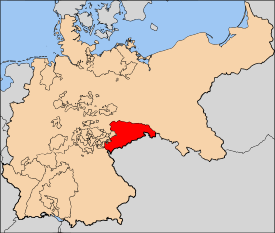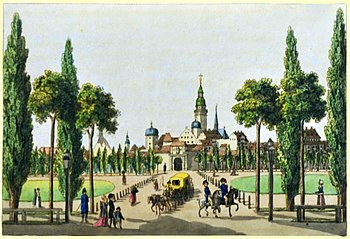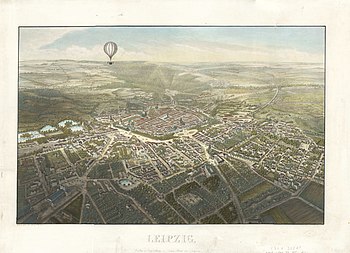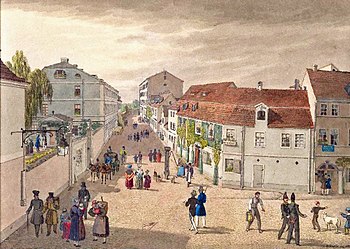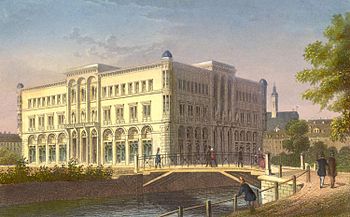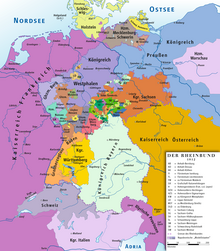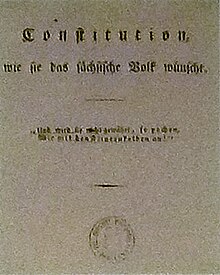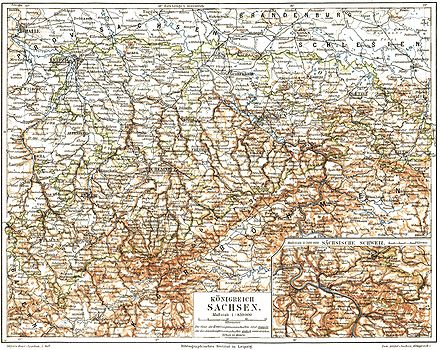Kingdom of Saxony
|
||||||||||||||||||||||||||||||||||||||||
The Kingdom of Saxony emerged from the Electorate of Saxony and existed from 1806 to 1918. From 1806 to 1815 it belonged to the Rhine Confederation and from 1815 to 1866 to the German Confederation . Since 1867 it was a federal state of the North German Confederation and from 1871 to 1918 of the German Empire . The capital was Dresden .
geography
Territory status 1806/07
The kingdom emerged from the Electorate of Saxony , whose territorial status, which was reached around 1800, mainly as a result of the transfer of the Saxon electoral dignity to the Wettin margraves of Meissen in 1423, the transfer of the electoral dignity from the Ernestine to the Albertine Wettins after the Wittenberg surrender in 1547 and the gain of Upper and Lower Lusatia resulted in the Peace of Prague in 1635.
The kingdom spanned the end of 1806
- the area of the old margraviate of Meißen consisting of the Meißnischer Kreis (including Meißen , Dresden , Torgau , Pirna , Oschatz , Riesa , Großenhain , Elsterwerda , Finsterwalde , Senftenberg ), the Leipzig district (including Leipzig , Grimma , Rochlitz , Borna ) and the Erzgebirge district (including Chemnitz , Zwickau , Annaberg , Freiberg ) including the old Schönburg dominion (including Glauchau ) and the neighboring (Saxon) Vogtland ( Vogtland district including Plauen ) to the south ,
- the old Saxon Kurlande with their capital Wittenberg ( Kurkreis including the County of Brehna , next to Wittenberg and others with Belzig , Bitterfeld , Liebenwerda ),
- Foothills in East and North Thuringia ( Neustädter Kreis, among others with Neustadt an der Orla ; Thuringian District among others with Langensalza , Sangerhausen , Weißenfels ).
- In addition, the margravates of Upper Lusatia (including Budissin [= Bautzen ], Görlitz , Löbau , Kamenz , Lauban , Zittau ) and Lower Lusatia (including Lübben , Guben , Sorau , Fürstenberg (Oder) ), the secularized monastery areas of Meißen ( including Bischofswerda , Wurzen ), Merseburg and Naumburg - Zeitz , the principality of Querfurt (including the associated area around Jüterbog and Dahme ) and the Harz counties of Stolberg and Mansfeld (including Eisleben , Hettstedt ).
- The Cottbus enclave was embedded in the margraviate of Niederlausitz , which Prussia had to cede to Saxony in the Tilsit Peace Treaty on July 9, 1807 (Art. 2 and 12 of the Franco-Prussian Agreement).
History of the kingdom
Effects of the French Revolution
The forerunner state of the kingdom was the Electorate of Saxony. Since the end of the Middle Ages, this had developed into a complex territorial complex in central Germany. Until the Silesian Wars it was one of the most important Protestant states of the Holy Roman Empire, but was then ousted by the northern neighbors of Brandenburg-Prussia. The relations with Prussia were reversed, was significantly shrunk so that the political significance of Saxony after the 1,763th Instead, the economy flourished and a highly developed urban and commercial landscape shaped the prosperous health resort at the end of the 18th century.
At that time, major changes were heralded in Europe. The political, social and economic conditions were reorganized in the whole of Europe in the course of the French Revolution after 1789. The revolutionary thoughts from France were heard here too. However, uprisings like those in France did not yet break out. It was not until 1790 that the Saxon peasant uprising against the repressive authorities of the landowners took place. These riots did not have the same dynamic as in France and were suppressed militarily in September 1790. Sections of the bourgeoisie and the intelligentsia intensified their criticism of the absolutist rule in the Electorate of Saxony under the influence of revolutionary ideas. The Saxon state opposed censorship regulations at the state's universities and police investigations, including severe penalties against well-known spokesmen.
In the 1790s, the European monarchies tried to suppress the revolutionary danger emanating from the French Revolution and to prevent further expansion into other countries and to stabilize the system of the Ancien Régimes again. This led to serious armed conflicts in Europe. According to the Pillnitz Declaration , Saxony was one of the countries that fought alongside Prussia against the French Revolution. Revolutionary France stabilized, fought back the invaders and began to expand deep into the territory of the Holy Roman Empire. Through the Reichsdeputationshauptschluss of 1803, 112 of the smaller and larger domains were dissolved as imperial estates, which amounted to a reorganization of the German Reich territory. On July 16, 1806, when the rulers united under French rule in the Confederation of the Rhine declared their exit from the empire, Emperor Franz II laid down the Roman-German imperial crown on August 6, 1806 following an ultimatum from Napoleon. The Holy Roman Empire had ceased to exist.
War with France on the side of Prussia





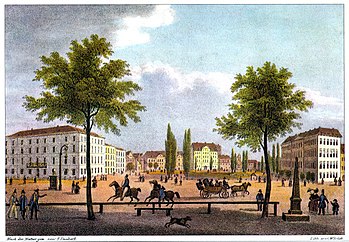


The situation was difficult for Electoral Saxony, which is not very important by European standards. Elector Friedrich August III persecuted until 1806 . therefore meticulously a political concept which largely renounced an active foreign policy and was based on the principles of neutrality , loyalty to the imperial constitution and peacekeeping. This also included exact compliance with alliance obligations once they had been made. In order not to come into conflict with the partitioning powers of Poland , Russia and Austria, Friedrich August renounced the Polish royal crown in 1792 . Even when Europe drifted apart in terms of power politics after 1804, with an Anglo-Russian offensive alliance expanded to include Austria on the one hand and the Confederation of the Rhine federated around the French Empire on the other, Electoral Saxony believed for a time that it could stay out of the global political dimension of disputes. The adherence to a consistent policy of neutrality was understandable from a Saxon point of view, since it had guaranteed 40 years of peace.
After the fall of the empire, the sovereignty was left alone without an alliance partner. On the initiative of Prussia, Saxony and Hesse-Kassel entered into contract negotiations to form a North German Confederation (defensive alliance) as a counterweight to the Rhine Confederation. This allusion to Prussia drew Electoral Saxony into the fundamental conflict with Napoleonic France. Although there was no formal alliance agreement with Prussia, the 22,000 Saxon soldiers united with the main Prussian army in the autumn of 1806 to oppose the French invasion. The Saxon troops were at war with Prussia on the battlefields of Jena and Auerstedt (1806) against Napoleonic France, which was striving for European domination. Here the united Prussian-Saxon army suffered a devastating defeat against Napoleon. As a result, all of Saxony was occupied. 10,000 Bavarian soldiers and a French city commander moved into Dresden. Leipzig was occupied by the French Marshal Louis-Nicolas Davout on October 14, 1806 and had to spend one million thalers to station the enemy soldiers in the city. But France tried hard to end the alliance between Saxony and Prussia and to take over the role of the Saxon protective power of Prussia.
Saxony was divided into four arrondissements . The administrative centers after this regional reform were Naumburg , Leipzig, Wittenberg and Dresden. Public life was now dominated by the French administration, which mainly took care of the collection of contributions, the confiscation of all taxpayers' money as well as the elector's property, the confiscation of all English goods and the maintenance of military hospitals. French garrisons were set up in Naumburg, Leipzig, Wittenberg, Dresden, Weissenfels and Merseburg . The Saxon administrative organs remained in place, but were bound by the instructions of Napoleon and his officials.
Peace with France and accession to the Confederation of the Rhine
With the signing of the Poznan Peace Treaty between France and Saxony, Saxony left the Fourth Coalition War . In the Peace of Poznan, Saxony, occupied by Napoleon, had to join the Confederation of the Rhine (Art. 2) and cede various areas in Thuringia (Art. 7), but received the Prussian enclave around Cottbus as compensation (Art. 6) and was transferred to Bavaria and Württemberg now also elevated to a kingdom (Art. 3). In addition, the Roman Catholic creed was legally equated with the Evangelical Lutheran creed in Saxony (Art. 5). The downside of the Posen Treaty was the increasing dependence of Saxony on France.
Elevation to the kingdom
On December 20, 1806, the ruling Elector Friedrich August the Just was proclaimed King of Saxony. The proclamation did not meet with any particular echo, probably because the title of king had been used in Saxony for more than a hundred years. Nevertheless, Friedrich August did not receive the royal dignity until the end of 1806 from Napoleon's hand and this time as the Saxon crown; a few months later, however, he was also used as ruler in Poland.
Upon accepting the royal dignity, King Friedrich August I publicly declared that he would keep the previous state constitution of Saxony unchanged. He confirmed this once more on May 10, 1807 at a meeting of the estates. This left the complicated system of coexistence of no fewer than 20 different territorial constitutions within Saxony, all of which had their own authorities, administrations, court constitutions and class corporations and which acted relatively independently of the central administration in Dresden. There was no shortage of reform efforts: between 1808 and 1815 no fewer than 43 publications on the problem of comprehensive reforms in the Kingdom of Saxony appeared. But the standardization of the different parts of the country and their constitutions, the introduction of specialist ministries, the simplification of the procedural rules or the separation of administration and justice remained unfulfilled dreams of the mostly bourgeois Saxon reformers.
In the Franco-Austrian War of 1809 , the Kingdom of Saxony as a member of the Rhine Confederation officially declared war on Austria on April 24th. Dresden was briefly occupied by Austrian troops on June 11, 1809 before it was liberated by French troops. At the decisive battle at Wagram on 5./6. In July 1809, Saxon troops fought on the French side and suffered heavy losses there.
Defeat and division of the kingdom at the Congress of Vienna in 1815

The Kingdom of Saxony also took part in the Russian campaign of 1812 with 21,000 soldiers as part of the Rhine Confederation. This ended in a military catastrophe for the invaders. On December 24, 1812, the Saxon ambassador at the headquarters of the Grande Armée in Vilnius , Major General Karl von Watzdorf , returned to his homeland and informed the Saxon cabinet about the real military situation beyond the official reports. In addition, the first survivors soon arrived on Saxon soil and reported on the destruction of the Grande Armée .
Napoleon, who stationed numerous new French armed forces in Saxony after his unsuccessful Russian campaign , chose the territory of Saxony as his own base of operations and the main theater of the coming Wars of Liberation on German soil against Russian, Austrian and Prussian troops. The rebuilding of the Saxon army and the supply of the French troops meant an immense financial burden for Saxony. On June 5, 1813, Friedrich August I convened a deputation of the estates to discuss the difficult procurement of the funds required by Napoleon with them. Due to the supply and equipment of the French and its own troops in the late spring and summer of 1813, Saxony got into a desperate economic situation.
The Battle of Bautzen , the Battle of Dresden and the Battle of the Nations near Leipzig were the military highlights of the battles for Saxony and Germany. Accordingly, the Saxon civilian population suffered a lot in the contested areas. Western Upper Lusatia were particularly hard hit by the fighting ( Bischofswerda was shot on fire and devastated) and 44 villages burned down, 260 villages looted, Räcknitz near Dresden and the villages around Leipzig were devastated during the Battle of the Nations in October 1813. In contrast to most of the other states of the Rhine Confederation, Friedrich August I did not take the side of the allies in the autumn of 1813, although parts of the military changed sides at the beginning of the wars of liberation in early 1813. King Friedrich August I fell into Allied captivity as an ally of Napoleon after the Battle of Leipzig. The General Government of Saxony was administered from October 21, 1813 to November 9, 1814 by Prince Repnin-Wolkonski . This organized the performance of contributions and troop contingents. Saxony lost 200,000 people during the war, famine and epidemics. 150 places were destroyed.
After the fall of Napoleon, Prussia was determined to completely annex Saxony. On February 28, 1813, Prussia and Russia agreed in the Treaty of Kalisch the mutual territorial claims in Europe in the event of a victory over Napoleon. In it Prussia was to be rewarded with all of Saxony and Russia with the Duchy of Warsaw. As a loser in the war, Saxony's status as a European middle power ended at the Congress of Vienna in 1815. The complete incorporation of Saxony by Prussia was only avoided due to the resistance of Austrian and English diplomats. They feared a too strong Prussia. In the midst of it, the Saxon envoy Friedrich Albrecht von der Schulenburg acted without official approval . Although he was vehemently committed to the unrestricted preservation of his country, as a loser in the war he had a poor negotiating position. In January 1815, the Saxon-Polish conflict threatened to escalate into another war. So for a short time new alliances were formed; Russia and Prussia faced Austria, France and Great Britain. Since both sides wanted to avoid another armed conflict, Prussia and Russia reduced their demands.
The Kingdom of Saxony was not dissolved, but reduced by more than half, from originally 35,801.35 km², 20,841.86 km² fell to Prussia, according to other information, 20,230 km² with 767,441 inhabitants. This corresponded to a 58.2 percent loss of territory and a 39.4 percent loss of the pre-war population. The Kingdom of Saxony thus had an area of 14,959.49 km² in 1815 and a population of 1,178,802 inhabitants. The areas to be ceded included Lower Lusatia with Cottbus and the northern part of Upper Lusatia around Görlitz (which was largely assigned to Silesia), the Kurkreis with Gommern and Barby, the Thuringian District and the Neustädter Kreis , Mansfeld, Querfurt , the secularized former Naumburg monasteries Zeitz and Merseburg as well as the northern parts of the Meißnische Kreis and on top of that some offices of the Leipzig district .
Saxony joined the alliance against Napoleon, who had returned from Elba, on May 27, 1815 and undertook to provide 8,000 men of the line and 8,000 men of the Landwehr to fight him.
For the practical implementation of the division of the country, as agreed in Article three of the peace treaty of May 18, 1815 between Saxony and Prussia, both sides each set up a commission for this purpose. On July 1, 1815, through a mandate from Karl August von Hardenberg , General Friedrich Wilhelm Leopold von Gaudi , who had already served as Governor General in Saxony, and the Council of State Johann Georg Friedrich von Friesen became members of the “ Royal Prussian Commission for Compensation with the Kingdom of Saxony ”and sent to Dresden. In Saxony, the " Royal Saxon Peace Execution and Disputes Commission " was launched. It took a total of four years until the ratification documents of the “ main convention ” could be exchanged in September 1819 . Many important trade connections had been interrupted by the new demarcation.
The reduced Kingdom of Saxony, to which Friedrich August I returned after an absence of more than a year and a half and where he was enthusiastically received in Dresden on June 7, 1815, had to struggle with considerable financial burdens from the division, but soon recovered economically. Saxony no longer played an important political role in Germany after 1815; the splendid times of the Saxon electors as the leading Protestant power in Germany were over, as was the Polish-Saxon personal union.
Riots 1830
King Friedrich August I died in 1827 . He was succeeded by King Anton - a ruler who continued the anti-liberal course of his predecessor and carried out only a few reforms. The population blamed this development less on the monarch himself than on his cabinet minister Detlev von Einsiedel . Einsiedel remained the politically dominant figure in the Kingdom of Saxony. The disappointed hopes of the population for a change of political course increased the discontent in the country. In June 1830 - before the July Revolution in France - the first unrest broke out in Leipzig. At this time, the 300th anniversary of the Confessio Augustana of 1530 was celebrated in the city. However, the people of Leipzig felt it was a harassment that the local authorities forbade the wearing of student uniforms - a symbol of liberalism at the time - during the solemn processions. The protest could only be suppressed with the help of a police presence. As a result of the French July Revolution, the protest was repeated on the streets of Leipzig in September 1830. The rigorous action of the police made the resistance of the attending craftsmen, students, manufacturing workers and apprentices against state authority and the magistrate even stronger than in June. In petitions handed over to the city council on September 4, 1830, the rebels accused the city administration of unnecessary harshness and arbitrariness. They also called for a renewal of the police force and lower taxes. From Leipzig, the protest spread to the royal seat of Dresden that same week. King Anton convened a security commission , which was chaired by his popular brother Friedrich August . On September 13, 1830, Einsiedel resigned at the request of the king. The more liberal Bernhard von Lindenau took his position as cabinet minister. The monarch also gave in to public pressure after Friedrich August co-reigned and the drafting of a constitution. The latter should finally come into force in September 1831.
Other events
Considered important events in the history of the kingdom
- foreign policy
- the loss of state sovereignty after the Prussian accession dictate to the North German Confederation in 1866. Originally Prussia wanted to completely incorporate the Kingdom of Saxony, but this could be avoided thanks to the negotiating skills of General Alfred Graf von Fabrice and the intercession of the Austrian Emperor Franz Joseph I. Fabrice was able to build up so much trust that it even retained its own Saxon Army Corps with its own standard, facilities, uniforms, and armament, and this was incorporated into the army of the North German Confederation . The solution to these aspects was the prerequisite for the Kingdom of Saxony to be preserved. In 1870/71 the kingdom took part in the Franco-Prussian War and in 1871 the country became part of the newly established German Empire. Since the armistice talks in France had hardened, the Chancellor Otto von Bismarck instructed the Saxon Minister of War, Alfred von Fabrice, to take over the talks. He was appointed Governor General for Occupied France and successfully brokered all matters important to carry out the peace preparations.
- domestic
- Saxony's transition to a modern constitutional and constitutional state with the adoption of the (first) Saxon constitution in 1831, the entry into force of the Saxon Civil Code in 1865 and the consistent separation of justice and administration in 1873/74, flanked, however, by political tensions (autumn riots 1830, May uprising 1849 , Rise of Marxist social democracy after 1870) and opposing developments ( reaction time 1849-1854, militarization from 1870),
- economically
- the rise of Saxony to the leading industrial and trading state in Central Europe, evident from the sales success and the economic dominance of Saxon industry in the Zollverein since 1834, the rapid development of an efficient long-distance railway network from 1837, the assertion of Leipzig trade fair trade against Frankfurt and the breakthrough of Leipzig as a world trading center after the introduction of the sample fair in 1895, accompanied of course by the decline of the classic small business and the spreading mass poverty (" pauperism ") as well as spectacular failures (such as the collapse of the Leipzig bank in 1901).
In 1918 the November Revolution led to the end of the monarchy , and on November 10th the proclamation of the " Free State of Saxony" by Hermann Fleißner in the Sarrasani circus followed. On November 13th, King Friedrich August III thanked . at Guteborn Castle in Guteborn near Ruhland . Saxony subsequently remained as a member state within the German Reich and, like this, began a comprehensive constitutional reform under Prime Minister Richard Lipinski . The republican form of government in Saxony was established by the provisional Basic Law of February 1919 and finally by the constitution of the Free State of Saxony of November 1, 1920 . As a free state (republic), Saxony was now a federal state of the Weimar Republic .
coat of arms
The large coat of arms since June 7, 1889 is a twice split and three times split shield with a split shield base .
The coat of arms shows in the shield
- Field 1 Margraviate of Meissen
- Field 2 Landgraviate of Thuringia
- Field 3 Palatine County of Thuringia (Lauchstädt)
- Field 4 Pfalzgrafschaft Saxony ( Pfalz Allstedt )
- Field 6 reign of Pleißen
- Field 7 Vogtland
- Field 9 County Orlamünde
- Field 10 County Landsberg
- Field 11 Margraviate Oberlausitz
- Field 12 County Eisenberg
In the base of the shield the signs for the Burgraviate of Altenburg and the County of Henneberg . In the gold-crowned heart shield (fields 5 and 8) the coat of arms shows the Saxon diamond . The crest stands for Vogtland, Thuringia, Saxony, Meissen and Upper Lusatia. The shield is held by a golden, red-tongued, resisting lion on the right and left. The shield is hung from the house order of the diamond crown. On the tape the motto “Providentiae memor” (“Mindful of Providence”). A purple, gold-crowned heraldic tent surrounds everything. The national colors are white and green.
Administrative division of the kingdom
Administrative structure before and after 1815
In the first decade of its existence, the Kingdom of Saxony was divided into the offices from the Middle Ages, which since the 16th century have been grouped into seven electoral Saxon districts ( Erzgebirge , Kur , Leipzig , Meißen , Neustadt an der Orla , Thuringia , Vogtland ). In addition, the Margraviates of Upper and Lower Lusatia had their own administrative structures; Likewise, the abbey areas ( Meißen , Merseburg , Naumburg - Zeitz ) and principalities ( Querfurt and the Harz counties of Mansfeld and Stolberg ) that had fallen to Electoral Saxony were not “circled”. (see list of the districts and other areas of Saxony )
With the “General Instructions to the District and Official Governors” of June 22nd, 1816, the administrative reorganization of the now much smaller kingdom was brought about. From the remaining parts of the country with axes were within the Saxon Erblande first thirteen larger office Bezirkshauptmannschaften formed as subdivisions directly Meissner (5), Erzgebirgische (4) or Leipzig (3) Kreishauptmannschaft were assumed. The small Vogtland district only formed an administrative team. In addition, the Margraviate of Upper Lusatia continued to have its own administrative structures: Under the Oberamtsregierung zu Budissin (= Bautzen), the state administration was divided into the "four cities with villages" (the term "four cities" refers to the part of Upper Lusatia that remained in Saxony cities of the old Upper Lusatian six-city federation : Budissin, Kamenz, Löbau, Zittau), on the other hand in the (Upper Lusatian) district .
Administrative division since 1835
In 1831 after the adoption of the Saxon constitution and the resulting unification of the kingdom under constitutional law, an administrative reorganization of the national territory became necessary. By the Order of 6 April 1835, therefore, were existing in the old dominions circular main teams and in the Oberlausitz , the chief official government repealed. Instead, four district directorates were set up with their headquarters in Budissin / Bautzen, Dresden, Leipzig and Zwickau. The Dresden district directorate initially consisted of five, from 1838 four administrative authorities and mainly comprised the previous Meißnische Kreis , but now also extended to the Eastern Ore Mountains. The district directorate of Zwickau was formed from the former districts of the Erzgebirge (including the rule of Schönburg ) and Vogtland and consisted of five administrative authorities. The Leipzig district directorate initially consisted of three, from 1838 four administrative authorities and, in addition to the previous Leipzig district, also comprised smaller areas of the formerly eastern Meissnian district. The district directorate Budissin / Bautzen comprised the Upper Lusatian part of the country and in the west some of the Abbey-Meissnian areas that were most recently part of the Meißnian district . It was only subdivided into two administrative authorities (Budissin / Bautzen, Zittau) in 1838.
Has existed since 1838
- the district directorate Dresden with the administrative authorities Dresden, Meißen, Pirna, Freiberg,
- the district directorate Leipzig with the administrative authorities Leipzig, Rochlitz, Grimma, Döbeln,
- the district administration Zwickau with the administrative authorities Chemnitz, Zwickau, Forchheim ( 1871: Annaberg), Plauen / Vogtl., Herrschaft Schönburg,
- the district directorate Budissin ( from 1868: Bautzen) with the administrative authorities Budissin / Bautzen, Zittau.
The administrative reform of 1873/74
With the Organization Act of April 21, 1873, the administrative structure of the kingdom was again decisively redesigned. The four District Directorates were abolished and instead re- circle Bezirkshauptmannschaften introduced. At the same time, the number of administrative authorities was increased to 25. The three largest cities of the kingdom, Leipzig, Dresden and Chemnitz, became district-free and were thus directly subordinate to the respective district headquarters. (The term Stadtkreis used for this today comes from Prussia and was not used in the Kingdom of Saxony.)
The newly created administrative structure only came into effect on October 15, 1874. Their importance also consisted in the fact that only now the full separation between justice and administration in the kingdom took place and the administrative authorities thereby became real lower administrative authorities. In 1878, the district administration of Glauchau was formed from the Schönburg rulership in the Zwickau district. The administrative authorities in Dresden were separated into the administrative authorities in Dresden-Altstadt and Dresden-Neustadt in 1880 (withdrawn in 1924). In 1900 a fifth district main team was created with Chemnitz, which was separated from the district main team Zwickau. Until 1918, the number of administrative authorities and district-free cities increased further.
Has existed since 1874
- in the district team of Bautzen
- in the Chemnitz District Main Team ( since 1900; previously Zwickau District Main Team ):
- in the Dresden district team
- the district-free city of Dresden
- the administrative authorities Dippoldiswalde , Dresden ( until 1880) or Dresden-Altstadt and Dresden-Neustadt ( from 1880 ), Freiberg , Großenhain , Meißen and Pirna
- in the district team in Leipzig
- in the district main team Zwickau
- the district-free cities of Plauen ( since 1907 ), Zwickau ( since 1907 ),
- the authorities in Auerbach , Oelsnitz , Plauen , Schwarzenberg and Zwickau .
List of the kings of Saxony
- 1806–1827 Friedrich August I the Just (* 1750; † 1827), 1807–1815 at the same time Duke of Warsaw ; previously since 1763 (under the name Friedrich August III.) Elector of Saxony and in 1791 elected King of Poland
- 1827–1836 Anton the Kind (* 1755; † 1836), brother of the previous one
- 1836–1854 Friedrich August II. (* 1797; † 1854), nephew of the previous one
- 1854–1873 Johann (* 1801; † 1873), brother of the previous one
- 1873–1902 Albert (* 1828; † 1902), son of the previous one
- 1902–1904 Georg (* 1832; † 1904), brother of the previous one
- 1904–1918 Friedrich August III. (* 1865; † 1932) ( abdication ), son of the previous one
See also
- Free State of Saxony
- History of Saxony
- Saxon coin history
- List of the Dukes of Saxony (-Wittenberg)
- List of the electors, dukes and kings of Saxony
- List of the tribal dukes of Saxony
literature
- Rudolf Kötzschke , Hellmut Kretzschmar : Saxon history. 2 volumes, Dresden 1935. (Reprinted in 1 volume, Frankfurt am Main 1965, Augsburg 1995 (below), pp. 299–397)
- Walter Schlesinger (Ed.): Handbook of the historical sites of Germany . Volume 8: Saxony (= Kröner's pocket edition . Volume 312). Unchanged reprint of the 1st edition 1965. Kröner, Stuttgart 1990, ISBN 3-520-31201-8 , pp. LII – LXX.
- Karlheinz Blaschke , Susanne Baudisch: Historical place directory of Saxony. (= Sources and materials on Saxon history and folklore. Volume 2). New edition in 2 volumes. Leipzig 2006. (= approx. 6000 entries)
- Ernst Eichler , Hans Walther (Ed.): Historical book of place names of Saxony. (= Sources and research on Saxon history. Volume 21). 3 volumes. Berlin 2001 (= approx. 5500 entries)
- Manfred Wilde : Between monarchy and democracy. 200 years of the Kingdom of Saxony, 190 years of the Delitzsch district, 175 years of the Saxon constitution. In: Albert Prince of Saxony, Duke of Saxony (Ed.): Kingdom of Saxony 1806–1918. Marienberg 2007, pp. 159-163.
- Philological-historical class of the Saxon Academy of Sciences in Leipzig in connection with the Land Surveying Office Dresden (Ed.): Atlas of the history and regional studies of Saxony. ( Memento from June 11, 2007 in the Internet Archive ), Dresden 1997 ff.
- Rudolf Forberger : The Industrial Revolution in Saxony 1800–1861. (= Sources and research on Saxon history. Volume 18). 2 parts in 4 volumes. Part 1: Berlin 1982, Part 2: Stuttgart 2003. (= with more than 1200 factory short stories)
- Andreas Oettel: On the administrative structure of Saxony in the 19th and 20th centuries . In: State Statistical Office of the Free State of Saxony (Ed.): Statistics in Saxony. 175 years of official statistics in Saxony (Festschrift) . tape 12 , no. 1 , 2006, OCLC 315121936 , pp. 69–98 ( online [PDF; 6.3 MB ; accessed on December 23, 2012]).
- Frank-Lothar Kroll: The rulers of Saxony, margraves, electors, kings. 1089-1918. Verlag CH Beck, Munich 2007, ISBN 978-3-406-54773-7 .
- Prince Ernst Heinrich of Saxony: My path in life from the royal castle to the farm. Paul List Verlag, Munich 1968, pp. 115–152. (including a report on his experiences during the Wilhelmine era, World War I, November Revolution)
- Chronicle of the Saxon royal family and its royal seat from June 18, 1853 to June 18, 1878. Dresden 1878. Digitized
- State manuals
- Royal Saxon Court and State Calendar. Leipzig 1807-1813; Royal Saxon court, civil and military state. Leipzig 1819-1828; Overview of the Royal Saxons. Court, state and military authorities. Leipzig 1832; State manual for the Kingdom of Saxony. Dresden 1837–1914.
- Leaderboards
- Tribe and rank list of the Royal Saxon Army. Dresden 1807-1849; Ranking of the Royal Saxon Army. Dresden 1850-1914; Court and military manual for Saxony. XII and XIX. (1st and 2nd KS) Army Corps. Stuttgart 1900; Seniority lists of the active officers ... of the Royal Saxon Army 1918. Dresden 1918.
Web links
- Peace of Poznan December 11, 1806
- Tilsiter Peace, Franco-Prussian Treaty of July 9, 1807 (PDF; 1.22 MB)
- Constitutional document for the Kingdom of Saxony of September 4, 1831 ( Memento of May 28, 2008 in the Internet Archive )
- Map of the Kingdom of Saxony , scale 1: 300,000, by A. Herrich, 21st edition (published before 1918)
- Hymn of the Kingdom of Saxony
- Kingdom of Saxony, administrative authorities and municipalities 1910
- Kingdom of Saxony - from a state to an industrial stronghold
Individual evidence
- ^ Saxony under Friedrich August III./I .: From the Electorate to the Kingdom, I. 1. The Electorate of Saxony 1768 to 1806. In: Isabella Blank: The punished King? The Saxon Question 1813–1815. Inaugural dissertation . Ruprecht-Karls-University. Mannheim 2013, DNB 1044485728 , p. 19.
- ^ Saxony under Friedrich August III./I .: From the Electorate to the Kingdom, I. 1. The Electorate of Saxony 1768 to 1806. In: Isabella Blank: The punished King? The Saxon Question 1813–1815. Mannheim 2013, p. 21.
- ^ Saxony under Friedrich August III./I .: From the Electorate to the Kingdom, I. 2. The Kingdom of Saxony between 1806 and 1812. In: Isabella Blank: The punished King? The Saxon Question 1813–1815. Mannheim 2013, p. 23.
- ^ Saxony under Friedrich August III./I .: From the Electorate to the Kingdom, I. 2. The Kingdom of Saxony between 1806 and 1812. In: Isabella Blank: The punished King? The Saxon Question 1813–1815. Mannheim 2013, p. 26.
- ^ Moritz Exner: The share of the Royal Saxon Army in the campaign against Russia 1812 , Verlag saxoniabuch, Dresden 2017, ISBN 978-3-95770-492-4 , reprint of the original edition Duncker & Humblot, Leipzig 1896, pp. 121, 152 and 172 Battle of the Moskva Borodino
- ^ Saxony under Friedrich August III./I .: From the Electorate to the Kingdom, I. 1. The Electorate of Saxony 1768 to 1806. In: Isabella Blank: The punished King? The Saxon Question 1813–1815. Mannheim 2013, p. 29.
- ↑ May to October 1813: Again in alliance with Napoleon, VI. 1. From Friedrich August I's return to Dresden to Austria's declaration of war on France on August 11, 1813. In: Isabella Blank: The punished King? The Saxon Question 1813–1815. Mannheim 2013, p. 120.
- ↑ May to October 1813: Again in alliance with Napoleon, VI. 1. From Friedrich August I's return to Dresden to Austria's declaration of war on France on August 11, 1813. In: Isabella Blank: The punished King? The Saxon Question 1813–1815. Mannheim 2013, p. 124.
- ^ The administrative reform under Friedrich August III./I. In: Maria Görlitz: Parliamentarism in Saxony: Kingship and popular representation in the 19th and early 20th centuries. LIT Verlag, Münster 2011, (p. 15–36), p. 31.
- ↑ Chapter V. Prussian Province of Saxony and Anhalt in the 19th century. In: Mathias Tullner: History of Saxony-Anhalt. CH Beck, 2008, ISBN 978-3-406-57286-9 , p. 55.
- ^ The monarchical administrative state and its opposition. In: Alexa Geisthövel: Restoration and March 1815–1847. Verlag Ferdinand Schöningh, Paderborn / Munich / Vienna / Zurich 2008, ISBN 978-3-506-76362-4 , p. 14.
- ↑ Hubert Kiesewetter: Sources for the historical statistics of the Kingdom of Saxony in the industrial age (1750-1914). In: Wolfram Fischer, Andreas Kunz: Fundamentals of the historical statistics of Germany: sources, methods, research goals. Springer Fachmedien, Wiesbaden 1991, ISBN 3-531-12246-0 , p. 145.
- ^ The accession of Saxony to the German Confederation and the implementation of the division of the country, VI. 1. The accession of the Kingdom of Saxony to the German Confederation. In: Isabella Blank: The punished king? The Saxon Question 1813–1815. Mannheim 2013, p. 274.
- ^ The accession of Saxony to the German Confederation and the implementation of the division of the country, VI. 2. The implementation of the Saxon division. In: Isabella Blank: The punished king? The Saxon Question 1813–1815. Mannheim 2013, p. 276.
- ^ The accession of Saxony to the German Confederation and the implementation of the division of the country, VI. 2. The implementation of the Saxon division. In: Isabella Blank: The punished king? The Saxon Question 1813–1815. Mannheim 2013, pp. 278f.
- ^ Wolfgang Tischner: Anton. 1827-1836 . In Frank-Lothar Kroll (ed.): The rulers of Saxony. Margraves, electors, kings 1089–1918. Beck, Munich, 2007, pp. 237–262, here p. 227.
- ↑ Birgit Horn — Kolditz: The sphere of activity of the provisional Commun representatives of Leipzig 1830/31. City history. Announcements from the Leipziger Geschichtsverein e. V. , Sax, Beucha 2009, pp. 185-204, here p. 189; Johannes Hund: The Augustana Jubilee of 1830 in the context of church politics, theology and church life . Göttingen 2016, p. 363.
- ↑ Johannes Hund: The Augustana Jubilee of 1830 in the context of church politics, theology and church life . Göttingen 2016, p. 363.
- ^ Wolfgang Tischner: Anton. 1827-1836. In Frank-Lothar Kroll (ed.): The rulers of Saxony. Margraves, electors, kings 1089-1918 . Beck, Munich, 2007, pp. 237-262, here pp. 231-232.
- ^ Anna Fabrice-Asseburg, Andrea Engi, Manfred Beyer: Alfred Graf von Fabrice. The family history of the royal Saxon state and war minister . Beyer Verlag Sachsen for Culture and History, Dresden 2008, ISBN 978-3-9809520-8-8 , pp. 44–51.
- ↑ The concrete demarcation of the new district and administrative authorities took place with the announcement of July 10, 1816. It is not published in the law gazette, which only appeared from 1818, but in the Leipziger (pol.) Zeitung , item 137.


